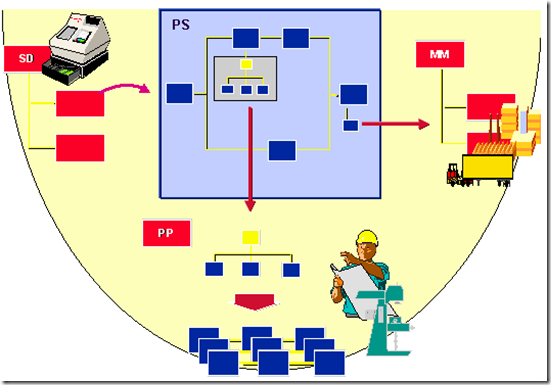分配:
通过物料对network activities的分配, 可决定项目中必须预留的或者采购的部件或原材料, 然后可通过MRP或采购操作激活这些分配.根据项目类型,有以下分配方法:
对于只有一些物料需求的项目,可以手工一个个分配物料到network activities. (material components individually.)
可以将带有BOM的物料分配到network activities, 然后explode the BOM (level by level).
如果该BOM含有很多组件(components)或者该BOM还在建立中, 在项目中对该BOM还有很多要修改的, 为了降低工作量,可以使用BOM transfer. 该方法是在BOM item与network activities创建逻辑连接(logical connections). 当需要对项目中的BOM进行更新时,用户仅需要再次执行分配.
如果在创建network时使用了standard networks, 可以通过assigning material to activities in standard networks预定义物料分配. 这样一来,当创建network,这些被分配的物料或组件就被拷贝了. 假设有一种生产项目,是生产各种不同的产品.虽然产品不同,但组成的原件和物料基本差不多, 项目结构也很类似.这样,用户可以创建configurable standard network, 该standard network被分配了一个super BOM, 该BOM包含了所有可能的组件. 当创建network, 系统根据被分配的属性值(characteristic value assignment),拷贝需要的组件到network.
Assembly processing是一种特殊的形式.PS与SD模块有了直接联系: 如果你在项目中输入一个物料,该物料符合1: 在销售订单中正确维护,2:该物料已经分配给了standard network, 这样的话, 从销售订单中就会自动生成项目结构.

采购:
当分配物料时,该物料是如何进行采购的呢?用户可以通过item category或Procurement Settings来决定.
The SAP standard item category N (non-stock item) always leads to direct procurement and to a purchase requisition, which is generated by the network. The system does not generate reservations that are relevant to MRP. You cannot post movements to stock for components with item category N.
对于N的物料,不会产生与MRP相关的预留,也没有库存转移.直接产生采购需求或直接购买.
Inventory management is envisaged for the SAP standard item category L (stock item). Depending on the settings in the material master and the bill of material, or the settings and assignments in the project system, the system generates for components with this item category “A Reservation” or “A Reservation and A Purchase Requisition”. For more information, see Procurement Settings
对于L的物料,基于配置,产生预留或预留与采购需求.
If during procurement via MRP, the requirements cannot be covered from stock, MRP decides whether the material is produced internally or procured externally. The system then generates as a procurement element either a planned order or a purchase requisition.
在MRP产生的需求时,如果库存不够无法满足需求, MRP决定是否内部生产或外部购买.MRP产生计划订单或采购需求.
If materials have a long lead time (production time or delivery time), you can generate preliminary purchase requisitions or planned independent requirements. For information about the prerequisites and settings necessary for this, see Advance Procurement.
对于有很长交货期的物料,可以产生初步采购需求,或计划独立需求.
Scheduling Material Flow:
在计划项目时,系统也会根据activity的时间决定物料的requirements dates.
使用networks中的多层BOM explosion, 用户可以精确控制需求时间, 因为用户不仅可以测试最高层物料(top component)还可以测试BOM项目中所有的从属料(subordinate).
Monitoring Dates是一个管理物料采购时间的工具(internal and external).
库存管理:
项目中的物料可以放在工厂库存或客户库存.如果network已经被分配给了销售订单,用户可以在销售库存中管理物料. For more information, see Managing Stocks of Material Components and Project Stock.
发货:
如果物料分配给了项目,用户可以在PS中创建deliveries, and as a result deliver independently of a sales order.
通过第三方销售订单,可以将外部购买物料直接从供应商送到客户.在network中留下地址,在物料中留下相同的地址.或者从SAP的地址数据库中读取地址.



